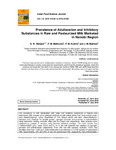Prevalence of Adulteration and Inhibitory Substances in Raw and Pasteurized Milk Marketed in Nairobi Region
| dc.contributor.author | Wanjala, G. W. | |
| dc.contributor.author | Mathooko, F. M. | |
| dc.contributor.author | Kutima, P. M. | |
| dc.contributor.author | Mathara, J. M. | |
| dc.date.accessioned | 2019-05-02T07:21:42Z | |
| dc.date.available | 2019-05-02T07:21:42Z | |
| dc.date.issued | 2018 | |
| dc.identifier.uri | http://ir.mksu.ac.ke/handle/123456780/4351 | |
| dc.description.abstract | The highest incidence of milk adulteration with water was in slum areas, while no adulteration was detected in pasteurized milk. The results indicate that pasteurized milk is of satisfactory quality with regard to adulteration with water, while raw milk marketed in Nairobi is likely to be adulterated. Pasteurized milk was found to be more likely to be adulterated with hydrogen peroxide than raw milk marketed in Nairobi. Therefore consumers may be exposed to residues of hydrogen peroxide on consumption of some pasteurized packaged milk. The highest level of antimicrobials in pasteurized milk was 33.3% in brands K.b and K.d while no residues were detected in brand K.c. The incidence of antimicrobials in marketed milk implies that consumers are likely to be exposed to possible drug residues. The incidence of antimicrobials in raw milk contributes to increased failures in controlled acidification of milk during the production of fermented milk products. High incidence of detection in pasteurized packaged milk is mostly contributed by residues of hydrogen peroxide and/or other sanitizer or sterilizer residues. | en_US |
| dc.language.iso | en_US | en_US |
| dc.publisher | Asian Food Science Journal | en_US |
| dc.subject | Nairobi | en_US |
| dc.subject | Market milk | en_US |
| dc.subject | Adulteration | en_US |
| dc.subject | Water | en_US |
| dc.subject | Antimicrobials | en_US |
| dc.subject | Hydrogen peroxide | en_US |
| dc.title | Prevalence of Adulteration and Inhibitory Substances in Raw and Pasteurized Milk Marketed in Nairobi Region | en_US |
| dc.type | Article | en_US |
Files in this item
This item appears in the following Collection(s)
-
School of Agricultural Sciences [118]
Sholary Articles by Faculty & Students in School of Agricultural Sciences

